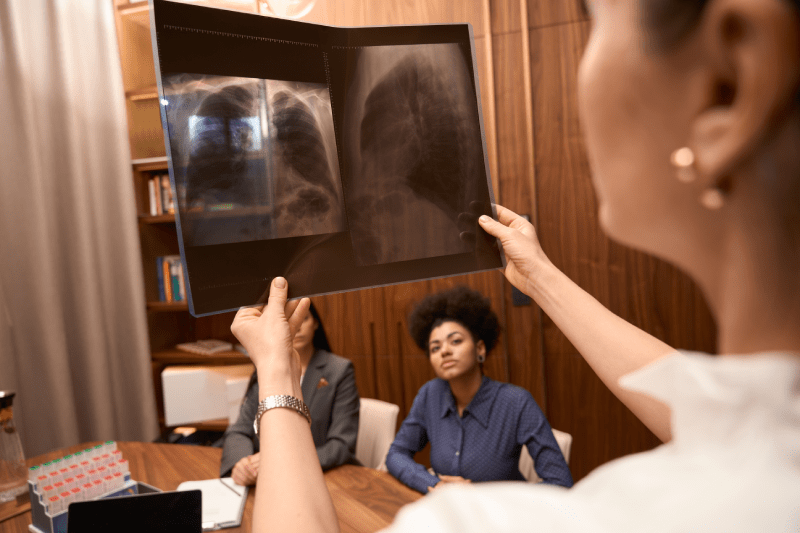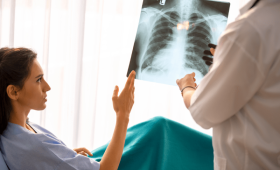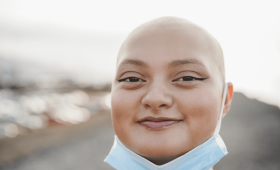What Is The First And Most Important Step To Take After Diagnosis?
The first and most important step after diagnosis is to accept the situation without panicking and to reach a multidisciplinary specialist team. Applying to a center specialized in oncology forms the foundation of the treatment process. At this center, a Tumor Council consisting of a medical oncologist, radiation oncologist, thoracic surgeon, pathologist, and radiologist should convene to evaluate your specific situation (tumor type, stage, genetic structure). This teamwork is essential for determining a personalized and up-to-date treatment plan.
Which Imaging Tests Must Absolutely Be Repeated In Lung Cancer Diagnosis?
After lung cancer is diagnosed, a PET-CT (Positron Emission Tomography – Computed Tomography) scan must absolutely be performed to definitively determine the stage (spread) of the disease. PET-CT shows the regions where cancer cells are metabolically active, detecting whether the tumor has spread to surrounding tissues or distant organs (such as bone, liver, brain). This definitive staging is vitally important for avoiding unnecessary surgical interventions and correctly determining the treatment strategy.
How Long Does The Process To Start Treatment Take After Diagnosis?
The process to start treatment after diagnosis usually requires a few weeks of evaluation. During this time, molecular (genetic) tests on the biopsy material are completed, staging is finalized with PET-CT, and the Tumor Council meets. Lung cancer treatment is time-critical, but these preliminary evaluation stages must be completed meticulously to avoid rushing into the wrong treatment. In centers in Turkey, this process is carried out quickly and in compliance with international standards.
What Details In Biopsy Results Determine The Treatment Option?
Biopsy results contain vital details that determine not only the presence of cancer but also its type (Small Cell/Non-Small Cell) and molecular subtype. Especially in Non-Small Cell Lung Cancer (NSCLC), the presence of genetic mutations such as EGFR, ALK, ROS1 or the expression of the PD-L1 protein is sought. These molecular markers indicate whether the patient will respond to smart drugs or immunotherapy instead of chemotherapy, which fundamentally changes the effectiveness and course of the treatment.
How Does The Tumor Council Decide On The Treatment?
The Tumor Council places all the patient’s medical data (imaging, pathology, laboratory) on the table and makes a treatment decision based on consensus. The decision is made according to the cancer’s stage, the patient’s general health status (performance status), age, and most importantly, the molecular analysis results. The council determines whether surgery, chemoradiotherapy, or a combination of targeted systemic treatments is the most appropriate. This collaborative decision-making process maximizes the success of the treatment.
Why Is Staging Vitally Important In Lung Cancer?
Staging, by determining the size of the tumor, its spread to lymph nodes, and distant organ metastasis (TNM system), is vitally important because it indicates the main goal of the treatment to be applied. The goal in early stages (Stage I-II) is to achieve complete cure with surgery. In advanced stages (Stage IV), the goal is to control the disease with systemic treatments to prolong life and improve the quality of life. Incorrect staging leads to incorrect treatment and a low chance of success.
What Are The Main Methods Used In Lung Cancer Treatment?
The main methods used in lung cancer treatment are surgery (VATS/Robotic Surgery), radiotherapy (SBRT/VMAT), chemotherapy, targeted smart drugs (Targeted Therapy), and immunotherapy. The treatment plan is determined by using these methods alone or in combination, depending on the type of cancer. For example, surgery is prioritized in early-stage NSCLC, while immunotherapy and smart drugs come to the forefront in advanced stages. Chemoradiotherapy is the main method in Small Cell Lung Cancer.
When Does Surgical Treatment Cease To Be An Option?
Surgical treatment ceases to be an option when the cancer has metastasized to distant organs (Stage IV) or when the tumor is too close to vital vessels and bronchi making complete removal impossible. Furthermore, in cases where the patient cannot tolerate surgery and anesthesia due to reasons like advanced heart or lung failure, or very advanced age, local methods like SBRT are preferred over surgery. In situations other than surgery, systemic treatments come into play.
What Preparations Are Necessary Before Starting Smart Drug Treatment?
The most critical preparation before starting smart drug treatment (targeted therapy) is the establishment of a definitive genetic (molecular) diagnosis. The presence of specific mutations (EGFR, ALK, etc.) that will respond to treatment in the patient’s cancer cells must be confirmed by biopsy or liquid biopsy. Additionally, the patient’s general health status, liver and kidney functions must be checked, and potential drug interactions must be evaluated. This meticulous preparation enhances the success and safety of the treatment.
To Which Patients Is The Combination Of Chemotherapy And Immunotherapy Applied?
The combination of chemotherapy and immunotherapy is generally applied to metastatic (Stage IV) NSCLC patients. It is preferred especially in patients with low PD-L1 expression in the tumor or without a specific genetic mutation. Chemotherapy kills cancer cells, releasing antigens that activate the immune system and increase the effectiveness of immunotherapy. This synergistic approach makes the treatment more long-lasting and effective, prolonging patients’ survival.
How Should I Change My Lifestyle During Cancer Treatment?
Changing your lifestyle during cancer treatment is vitally important for the success of the treatment. Quitting smoking completely is the first rule. In addition, maintaining regular, low-intensity physical activity (walking), focusing on a protein-heavy balanced diet to preserve muscle mass, and avoiding stress are necessary. These lifestyle changes increase the body’s resistance against the side effects of treatment and support the immune system, contributing significantly to a better prognosis.
What Supports Are Available To Cope With Treatment Side Effects?
Multidisciplinary supports are available to cope with treatment side effects. These include advanced-generation antiemetic drugs for nausea and vomiting, palliative care specialists for pain management, infection prevention protocols for managing a low immune system, and psychological support for effects like hair loss. Dietitians create personalized nutrition plans against the risk of appetite loss and weight loss. Balancing being active with sufficient rest is essential for effective symptom management.
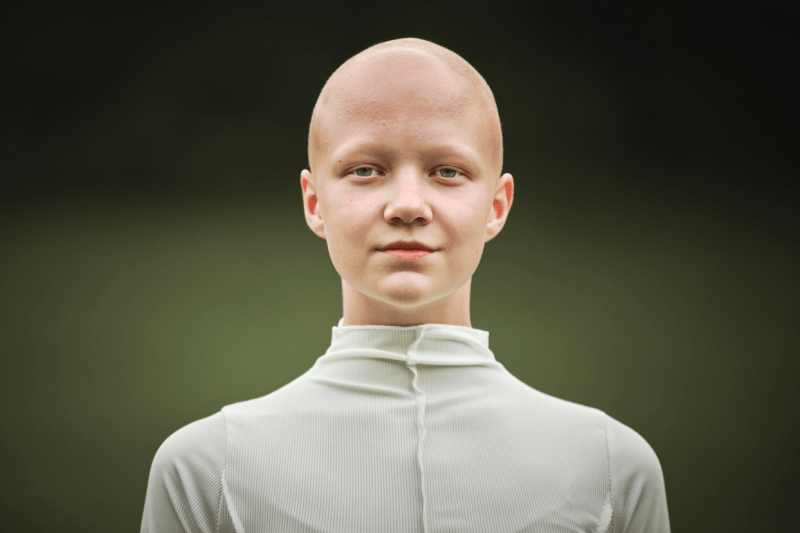
When Is It Necessary To Get A Second Opinion In Lung Cancer?
Getting a second opinion in lung cancer is strongly recommended, especially if the diagnosis is a rare subtype, the treatment plan is very aggressive, or the patient has doubts about the treatment options. Having a second expert team (preferably a Tumor Council at an internationally accredited center) independently evaluate all data guarantees the patient access to the correct and up-to-date treatment and increases the patient’s confidence in the treatment roadmap.
When Is Radiotherapy Preferred Over Surgery In Early-Stage NSCLC Patients?
In Early-Stage Non-Small Cell Lung Cancer (NSCLC) patients, SBRT (Stereotactic Body Radiotherapy) is preferred over surgery when the patient’s advanced heart or lung diseases make the operation high-risk. SBRT is a minimally invasive method that applies a high dose of radiation precisely to the tumor, offering local control rates similar to surgery. This method allows the patient to avoid the stress of general anesthesia and surgery, providing rapid recovery.
What Is The Treatment Strategy In Small Cell Lung Cancer (SCLC)?
Since Small Cell Lung Cancer (SCLC) spreads rapidly, the treatment strategy is generally based on the simultaneous application of chemotherapy and radiotherapy (concurrent chemoradiotherapy). Surgery is a very rare option and is only considered in very limited situations. If the disease has spread throughout the body (extensive stage), treatment usually involves combinations of chemotherapy and immunotherapy to systematically control the disease. Prophylactic cranial irradiation (PCI) may also be applied to prevent the risk of early brain metastasis.
How Are Costs Determined In Lung Cancer Treatment?
Costs in lung cancer treatment depend on many factors such as the type of drugs used (smart drugs, immunotherapy), the duration of treatment, the length of hospital stay, and the sophistication of the technology used (Robotic Surgery, SBRT). In Turkey, these costs are generally 50-70% lower compared to Western countries. Health tourism centers offer transparent, all-inclusive packages covering treatment, accommodation, and transfer for international patients, eliminating cost uncertainty.
What Is The Importance Of Receiving Psychological Support During The Treatment Process?
Receiving psychological support during the treatment process is critically important for increasing the patient’s compliance with treatment, preserving the quality of life, and strengthening stress coping mechanisms. Psycho-oncology specialists at oncology centers help the patient and their family deal with emotional difficulties such as anxiety, depression, and fear. Strong psychological support reinforces the patient’s belief in the treatment and indirectly accelerates the recovery process.
In Which Cases Is Chemotherapy The Priority Treatment In Lung Cancer?
Chemotherapy is the priority treatment, generally in metastatic (Stage IV) NSCLC patients where specific genetic mutations are not detected (often combined with immunotherapy) or in the extensive stage of Small Cell Lung Cancer (SCLC). Chemotherapy provides systemic control by targeting the rapidly proliferating cells of the tumor. In situations where molecular tests do not offer a targeted treatment option, chemotherapy remains the most widely used systemic tool.
How Long Is The Recovery Period After Minimal Invasive Surgery (VATS/Robotic Surgery)?
The recovery period after minimal invasive surgery (VATS/Robotic Surgery) is dramatically shorter compared to traditional open surgery (thoracotomy). Patients typically stay in the hospital for 3-7 days and can return to light daily activities within 2-4 weeks. Full recovery and return to activities like intense sports or heavy lifting usually take 6 to 8 weeks. Rapid recovery facilitates the patient’s early commencement of chemotherapy or radiotherapy, if needed.
What Is The Difference Between VMAT And SBRT Used In Radiotherapy?
The fundamental difference between VMAT (Volumetric Modulated Arc Therapy) and SBRT (Stereotactic Body Radiotherapy) is the purpose and dose of application. VMAT adjusts the dose by sparing the healthy tissue surrounding the tumor and is generally used in the standard treatment of larger area tumors like Stage III. SBRT applies a very high dose in a short time, like 1-5 sessions, with the aim of providing local control equivalent to surgery for small, early-stage tumors or metastases.
How Often Should The Follow-Up Process Be Done In Lung Cancer?
The follow-up process in lung cancer is generally done every 3 to 6 months during the first two years, and then gradually reduced until the fifth year. Follow-up includes physical examination, blood tests, and thorax/abdomen computed tomography (CT) scans. Frequent follow-up is vitally important for detecting the risk of early recurrence. The first two years are particularly the period when the probability of the disease recurring is the highest.

What Is The Method For Early Detection Of Resistance Development In Targeted Therapies?
The method for early detection of resistance development in targeted therapies (smart drugs) is generally done with liquid biopsy (tumor DNA analysis from blood) and regular imaging (CT/PET-CT). Liquid biopsy can detect the emergence of new mutations or resistance mechanisms even before the tumor regrows. This early detection offers oncologists the opportunity to quickly switch to a different treatment strategy and helps sustain the treatment’s success.
Can The Type Of Lung Cancer Change During Treatment?
Yes, although rarely, it can be observed that some subtypes of Non-Small Cell Lung Cancer (Adenocarcinoma) develop resistance to targeted therapies and transform into Small Cell Lung Cancer (SCLC). This transformation is usually a sign of aggression and necessitates a complete change in treatment. This situation explains why oncologists request a new biopsy or liquid biopsy when resistance develops.
How Much Do Lung Functions Improve After Lung Cancer Treatment?
Functional recovery after lung cancer treatment depends on the applied treatment. Although there may be some reduction in lung capacity after surgery (especially lobectomy), the remaining lung tissue compensates over time. Pulmonary rehabilitation (lung physiotherapy) programs accelerate recovery. While hardening of the lung tissue (fibrosis) or radiation pneumonitis may develop after radiotherapy, modern techniques minimize these side effects, and efforts are made to preserve the patient’s breathing capacity.
Is It Possible To Travel Or Work During The Treatment Process?
Traveling or working during the treatment process is possible, depending on the type of treatment used and the severity of the side effects. Patients taking oral smart drugs or receiving well-tolerated immunotherapy can continue their work life. Travel can be done during the rest periods between chemotherapy cycles and with the doctor’s approval. However, processes like stem cell transplantation or intensive radiotherapy may restrict the patient’s ability to travel or work. Foreign patients treated in Turkey can explore the country during treatment breaks.
Is Palliative Care Applied Only To Terminally Ill Patients?
No, palliative care is not applied only to terminally ill patients; on the contrary, it is a support system that should be included in every stage of treatment from the moment of cancer diagnosis. The purpose of palliative care is to improve the patient’s quality of life, control pain and other symptoms, and meet the patient’s psychological/social needs. When applied concurrently with cancer treatment, it significantly enhances the patient’s compliance and overall living comfort.
What Are The Advantages For International Patients Receiving Treatment In Turkey?
The biggest advantages for international patients receiving treatment in Turkey are affordable costs, rapid start of treatment, high quality proven by international accreditations like JCI, and access to the latest technology (VATS, SBRT, Immunotherapy). Patients avoid the long waiting lists found in Western countries, while also benefiting from comprehensive health tourism services such as airport transfers, accommodation, and medical translation, making the process more comfortable.
What Is The Success Rate Of Immunotherapy In Lung Cancer Treatment?
The success rate of immunotherapy in lung cancer treatment depends on the patient’s PD-L1 expression level and the tumor’s genetic structure. In patients with high PD-L1 levels, long-term and permanent response rates with immunotherapy can reach up to 40%. Immunotherapy has revolutionized the treatment of advanced-stage NSCLC by offering longer survival and a better side effect profile compared to chemotherapy in some patients. Success varies according to the patient’s unique molecular profile.
How Significant Is The Effect Of Quitting Smoking On Treatment Success?
The effect of quitting smoking on treatment success is extremely high and vital. Smoking reduces the effectiveness of chemotherapy and radiotherapy, slows down the healing rate, and increases the risk of recurrence. Patients who quit smoking have significantly longer treatment response rates and overall survival periods compared to those who continue. Quitting smoking is the most important and most effective step the patient can take immediately upon starting treatment.
What Should Be The Nutritional Habits After Treatment?
Nutritional habits after treatment should aim to preserve muscle mass, strengthen immunity, and keep energy levels high. A Mediterranean-type diet that includes plenty of vegetables, fruits, whole grains, and lean protein, and avoids processed foods, is recommended. Adjustments specific to treatment side effects (low-fat, frequent meals for nausea; high-calorie, small portions for loss of appetite) should be made with the guidance of a dietitian.
What Are The Symptoms Of Recurrence In Long-Term Follow-Up?
Symptoms of recurrence to watch for in long-term follow-up include recurrent or worsening cough, return or worsening of chest pain, unexplained and rapid weight loss, difficulty swallowing, and bone pain as a sign of metastasis. If any of these symptoms appear, it is critically important to consult the oncologist immediately and undergo new imaging (CT/PET-CT) tests for the early treatment of recurrence.
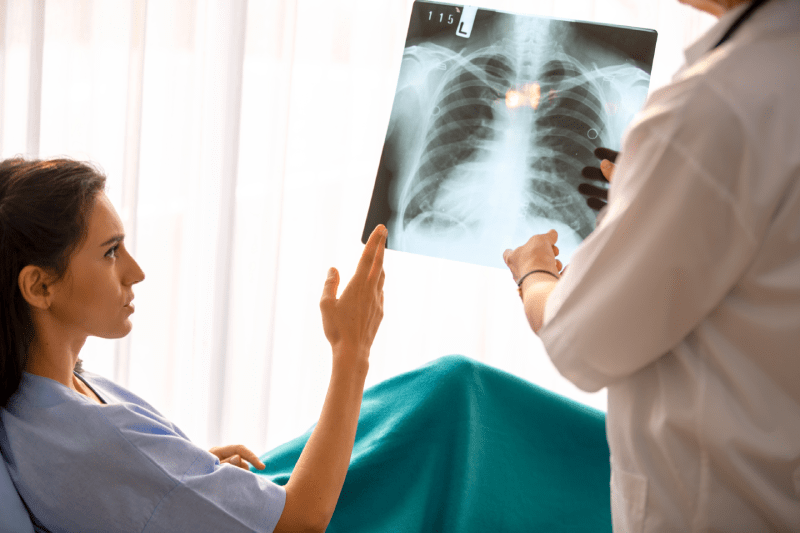
How Is Quality Control Performed In Oncology Centers In Turkey?
Quality control in oncology centers in Turkey is performed regularly by independent international organizations like Joint Commission International (JCI), in addition to national Ministry of Health inspections. JCI accreditation indicates that the centers meet the highest global standards in areas like patient safety, infection control, the currency of treatment protocols, and facility management. These accreditations provide assurance for international patients regarding the treatment quality.
What Professional Help Should I Get After Cancer Diagnosis?
The professional help you should receive after a cancer diagnosis includes specialists who are part of the oncology team: Medical Oncologist (drug treatments), Radiation Oncologist (radiotherapy), Thoracic Surgeon (surgery), Pathologist (diagnosis and molecular analysis), Dietitian (nutritional support), and Psycho-Oncologist (psychological support). The coordination of this multidisciplinary team is a fundamental necessity for the successful and holistic progression of your treatment process.
What Can Be Done To Improve Quality Of Life In The Long Term?
To improve the quality of life in the long term, it is important to maintain the commitment to a healthy lifestyle after completing treatment. Strict adherence to regular exercise, maintaining ideal weight, healthy nutrition, and annual regular medical follow-ups is necessary. Furthermore, avoiding a return to old habits (smoking, excessive alcohol) and maintaining connection with social/psychological support groups help preserve both physical and mental health in the long term.
What Is The Role Of Family Members In The Success Of The Treatment?
The role of family members in the success of the treatment is very significant. The family strengthens the patient’s compliance with treatment by providing emotional support, logistical help (appointments, medications), and moral support. Helping the patient coping with side effects like fatigue and loss of appetite and encouraging the maintenance of healthy eating habits are the family’s most important contributions. Family support enables the patient to remain psychologically strong.
What Are The Treatment Differences For Rare Types Of Lung Cancer?
Rare types of lung cancer (e.g., adenoid cystic carcinoma, carcinoid tumors) require different treatments than standard NSCLC or SCLC. Treatment generally relies more on a combination of surgery and radiotherapy. Some types, like carcinoid tumors, respond less to chemotherapy but may respond to endocrine therapies. The treatment plan for these rare types must be prepared specifically and very carefully in experienced oncology centers.
How To Contact To Start Lung Cancer Treatment In Turkey?
To start lung cancer treatment in Turkey, you should first gather your current medical reports, imaging (CT/PET-CT), and pathology results. Then, contact Cure Holiday, which provides international health tourism consultancy. Cure Holiday forwards these reports to the most suitable and expert oncology centers in Turkey, offering you a personalized treatment plan, cost quotation, and a roadmap that includes all travel/accommodation organizations. This is the start of your fast and reliable treatment process.
